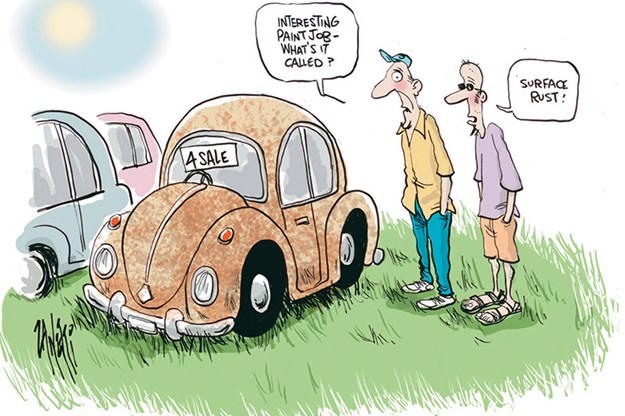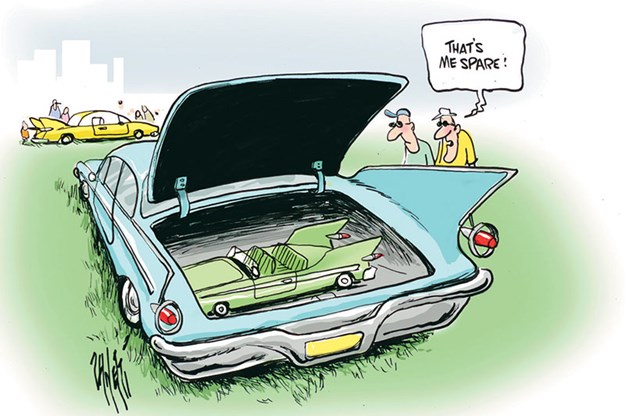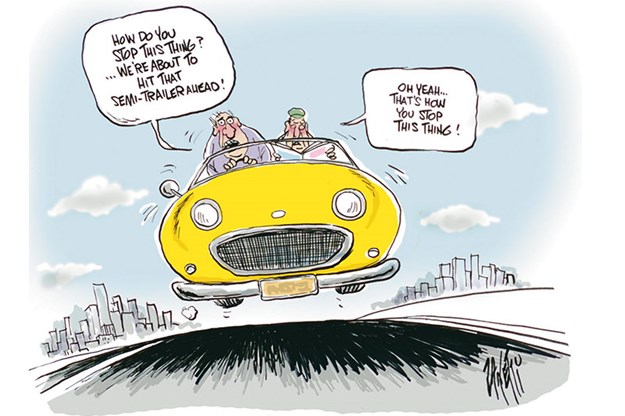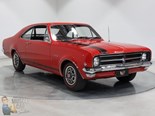10 Reasons to own a unique or 'special' car



|
You'd be mad not to own a 'special' car, reckons Dr John Wright
For our readers ‘unique’ is a special adjective. Let me start by saying what it’s not.
From Unique Cars #300, Jun/Jul 2009
In 1968, when Holden introduced the ‘New Generation’ HK models, the advertising boasted the range of model variants, colour choices and options was so vast that it was possible to build ‘x’ number of million cars without two being identical. Well, yes. But colour alone does not a unique car make, although it often adds value. Any HK has achieved unique car status by now, but in a way its manufacturer perhaps did not envisage. The day before yesterday’s mass-market transportation device now earns the ‘classic not plastic’ bumper sticker.
It’s probably a fair generalisation to say that the unique car turns the heads of many people who normally couldn’t give a hoot about cars. I think an HK ute or a Brougham (let alone a Monaro) would pass that test in most parts of Australia.
Achieving recognition is perhaps one reason for owning a unique car but there are many better ones. There are also some downsides. Let’s start with the positives…
1. The entry price can be low
You don’t have to start with an Italian supercar. A 1950s or ’60s Volkswagen Beetle, a Hillman Minx, or an FE Holden all cut this mustard. If the budget is limited, and ultimately everyone’s is, choose a car where parts are readily available and not too expensive.
An XK-engined Jaguar costs more to buy but there are specialists who will do a reconditioned changeover engine including removal and refitting for $5000. Try that with a Porsche or Ferrari, or even a BMW six.
2. Meet like-minded people
Last year, on the Armstrong Siddeley Outback Tour, which meandered around northern New South Wales and western Queensland, one Englishman who had travelled out especially for the event told me that the best thing about being in the Armstrong Siddeley Car Club was the lasting friendships he had made. He just happened to be a retired barrister, so presumably not a man short of his own social circle outside the world of classic English cars.

3. A theory of relativity
The contrast with modern cars provides a reminder of relativity. It can feel like 30 seconds worth of work to make it to 100km/h from rest, and sometimes it actually does. Typical mid-’50s English fours need nearly 20 seconds to reach 80km/h. You can use a higher percentage of the performance of most older cars – I’m not talking here about a Porsche 911, E-Type or Corvette Stingray.
When I lost some licence points in the early-’90s, I decided that if I lost any more I’d buy something like an MG ZA Magnette, a car in which breaking the 110km/h limit on the F3 by much would require intention. With the highest open-road speed limits (Northern Territory excepted) being 110km/h, many pre-1960 and most pre-’50 cars have to work quite hard to sustain it.
And accelerating in heavy traffic can be a challenge in your side-valve Morris Minor or even your Rover 90. Then there’s the little matter of brakes.
4. You will probably become a safer driver
I came up against the braking issue after perhaps a 15-year period in which I mainly drove cars manufactured after about 1965. Then, researching a story for Wheels magazine, I drove an early-‘50s Ford Custom. The pressure required to decelerate modestly from 50km/h was astounding. It felt like it wasn’t going to stop at all!
You immediately appreciate modern disc braking systems and it becomes habitual to leave more distance between you and the car in front, as well as being ultra-conscious of following traffic.
Old cars require more mechanical sympathy. And the mastery of double-declutching will add to your confidence. You actually need to be an OK driver to manage most classics in 21st century traffic. Other drivers mostly have no idea of the limitations of old cars.
5. A different and more involving experience of travel
With most unique cars made before about 1970, you’ll find the whole experience of undertaking a long trip is entirely different. Gearing was much lower. Upmarket models often came with overdrive on third and fourth gear to cut engine rpm and improve fuel economy as well as (sometimes) providing a higher top speed.
But I find a special pleasure in the fact that highway driving has an aural soundtrack that doesn’t come from the radio. Consider the strange case of my 1985 Jaguar XJ Series III. It has a full racing exhaust system, which isn’t what most doctors would order. But, you see, I like all that motorsport heritage associated with the XK engine and if I want a quiet drive, I’ll take another car. I am also bound to report that even before these mechanical modifications were made, the Jag still sounded pretty busy at 110km/h because the tachometer needle was registering 3000rpm. It may have been one of the quietest cars around town but not at highway speeds. Yes the XJ Series III does deserve to be classed as a pre-’70 model inasmuch as its origins date to the original XJ6 of 1968.
I don’t own it now, but my 1979 Ford LTD Cartier 351 was a thrill on the open road, especially when contemplating the litres slurped per 100 kilometres. You may argue with me re: the Jag, but I don’t think many petrolheads could resist giving a 351 engine extractors, camshafts and a muscle-bound Holley (cue Bathurst!). Believe me, driving 2000km between the Mornington Peninsula and the Sunshine Coast, that engine was a constant companion; it was, I imagine, a bit like being back in the womb.
Wafting in a modern car might be more relaxing but is less involving, and isn’t involvement what we crave? On the aforementioned Armstrong Siddeley Tour, my beloved wife Jennie frequently offered the view that it would have been much more comfortable in her BMW X5. Yes, but it would hardly have been an adventure!

6. Opportunity to time travel
‘You can’t repeat the past’ may be one of the lessons of F. Scott Fitzgerald’s The Great Gatsby, but many owners of unique cars know it’s not true. The whole old car thing is by no means all about cars. Often owners of classic vintage or even early post-war models wear fashions of the time to special functions. This can be a wonderful holiday from 21st century stresses. Leave the mobile phone at home. Even in 1990 most of us didn’t have one of those new-fangled devices. And you’d feel like an idiot fiddling with your Blackberry in your morning suit beside your Rolls-Royce Silver Dawn!
7. new sporting interest, perhaps?
Some unique cars open the way for a new sporting interest, such as super sprints, motorkhanas and historic rallying. If you buy a Subaru Impreza WRX and join the local club, you’re likely to find yourself on a racetrack.
8. ngage your imagination
I’ve found that it has only been in quite recent years that my ownership of several unique cars has driven me to read just about everything I can find on them. Perhaps that’s because I used to swap my cars so frequently. But I now find longevity of ownership – far from dulling my interest – actually intensifies it. Go on, ask me about a 1956 Armstrong Siddeley Sapphire 236 and prepare to have your ears bent for at least five minutes.
9. Get your hands dirty
Even those who don’t normally open the bonnet of their ‘modern’ will find some rewards in tinkering. You may need to prime the fuel pump and you will certainly need to check the water and oil regularly. The idling speed can be adjusted by a single, easily accessible screw on most carburetted cars. You could invest in a grease gun and a pair of ramps and actually discover what your car looks like underneath. Hey, you may become a different person.
10. It’s cheaper than golf
The unique car hobby can be very inexpensive, even (though rarely) profitable. Compare membership of an upmarket golf club in Sydney or Melbourne over a 20 or 30-year period and look how much you’ll have to show for that at the end of it.

And the downsides…
1. Tests your patience
Patience acquires a whole new meaning when you have to wait for a component to be made or to source something from overseas. The return of rust some years after its removal serves as another reminder of a problem now mostly solved by the automotive industry.
2. Possible bottomless bills
If you’re not on the tools yourself, expenses can blow out, or up. I have now had my Armstrong Siddeley for nearly five years, having paid just $5000 for it. But if the engine had blown up in the first year or so, I would have been most reluctant to spend maybe more than the purchase price getting it fixed.
3. Becoming anal retentive
Obsessiveness is an attendant hazard. I won’t mention the marque but I’m a member of one chat site where it seems that many of the members live their entire life around their car. A question about windscreens or even tyre size can linger on for weeks.
4. They don’t build them like they used to
And in many respects that’s just as well. I’ve mentioned rust and poor brakes. Throw in the lack of air- conditioning or adequate demisting, token windscreen wipers and nowhere to store water bottles and mobile phones and you start to get the bleak picture.
5. Storage for the car
I have undercover (actually under-verandah and thus sometimes under dog wee or spilt red wine) space for five of my actual cars or six, if they were all WRX-length. But if five cars are in there, it’s hard to get around in the space, so mostly only about three are resident and they argue among themselves about this. Rather than pay to increase the space, I’d prefer to add to the collection. This can be an occasional source of marital friction. But you won’t want to leave your newly acquired Pegaso or Ford Pilot out in the weather.
6. Car club bores
Car clubs can be a mixed blessing. There’s always the risk of being cornered by the bloke who has owned 27 Brand X and never even sat in Brand Y. One-marque mania is a sad affliction.
7. The possible need of more than one
Which segues into my final point. One marque cannot cover all bases. As I write in my book, My Other Wife is a Car, for the true tragic one car can never be enough. But your spouse may not get it.
Unique Cars magazine Value Guides
Sell your car for free right here
Get your monthly fix of news, reviews and stories on the greatest cars and minds in the automotive world.
Subscribe

.jpg)







.png)



